Key Takeaways
- Spanish customs shaped local attire in New Spain.
- Bright dyes and native motifs merged with European fabrics.
- Social class influenced garment choices and color palettes.
- Trade routes introduced exotic materials.
- New weaving and embroidery styles emerged.
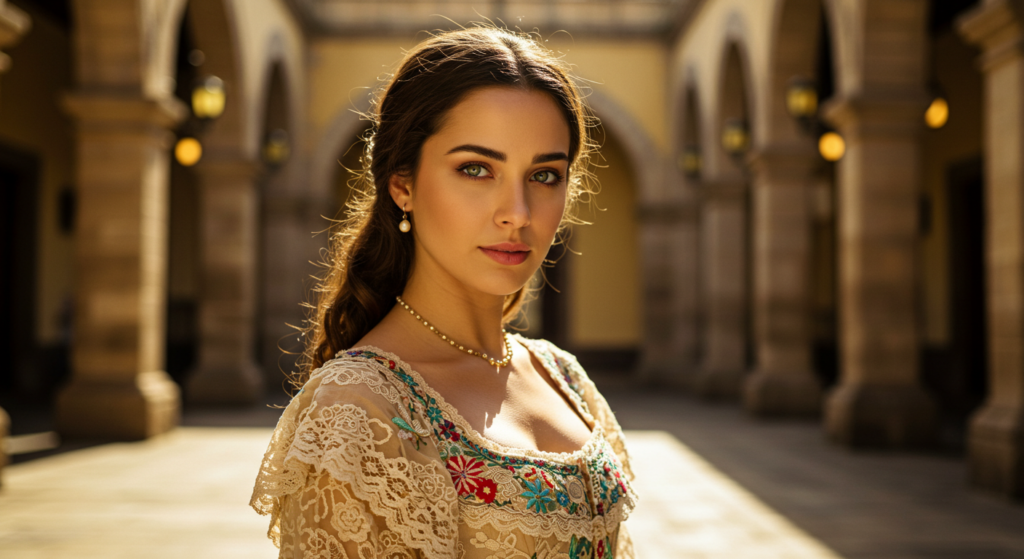
Colonial Mexico saw vibrant blends of Spanish and Indigenous fashion. Silk, cotton, and wool flowed into markets. Natives had their own rich textile traditions.
Spanish rule molded new dress codes, colors, and silhouettes. People adjusted clothing to climate, class rules, and local resources.
Strong commercial links from Spain and Asia brought fresh materials and designs. Over time, tradition and outside trends fused. This created unique outfits that remain part of Mexico’s cultural heritage.
Blending Spanish Tradition with Indigenous Textiles

Spanish Influence on Early Garments
Conquistadors arrived with strict dress ideas. They favored tailored jackets, breeches, and fitted bodices. Silk, velvet, and lace showed status. Locals noticed these materials. They began weaving Spanish styles into everyday looks. Spanish laws dictated clothing for each social level. This shaped how people paired colors and fabrics.
Indigenous Fabric Heritage
Pre-Hispanic weavers created cotton and agave cloth. Their designs featured symbols of faith, nature, and daily life. Dyes came from cochineal insects, plants, and minerals. After Spanish conquest, local weavers met new techniques from Europe. They used updated looms and new threads. That sparked inventive blends of old and new.
Color as Cultural Marker
Different classes preferred different hues. Wealthy elites wore deep reds, intense blues, and lustrous gold. Common folk stuck to earthy browns and grays. Access to dyes often depended on status. Cochineal became a prized export. It produced a vibrant red. This color grabbed attention in Spanish courts. It spread across Europe as a symbol of Mexican artistry.
Garments of Status and Class

Clothing as Social Divider
Spanish rule introduced laws called “pragmaticas.” These dictated what certain groups could wear. Silk, gold embroidery, and certain dyes were restricted to elites. Commoners had fewer options. But resourceful artisans found ways around these rules. They blended accessible materials with subtle designs.
Enforcement of Dress Codes
Colonial authorities monitored attire at public events. They insisted on correct clothing to maintain social order. Officials fined those who broke the rules. Even so, local markets sold a range of threads. This sparked creativity among the general population. People paired cheaper cloth with bright local dyes.
Rise of Mixed-Style Outfits
Some wealthy families embraced Indigenous motifs. They commissioned local weavers to fuse Spanish silhouettes with native patterns. That created distinctive looks. Velvet jackets might have embroidered Aztec symbols. Silk skirts could feature local flowers. This exchange bridged class divides. It also boosted respect for local textile skills.
Trade Connections and Imported Materials

Galleon Routes and Asian Silks
From Acapulco, the Manila Galleon arrived. It carried Chinese silks and embroideries. These goods flooded colonial markets. Spanish aristocrats in Mexico City treasured them. Local dressmakers adopted exotic prints and textures. People matched them with local dyes and motifs. This blend produced refined garments.
European Lace and Embroidery
Ships from Europe delivered lace, beads, and specialized threads. Artisans studied European designs. Lace cuffs, collars, and sleeves became popular. Church attire featured elaborate lace trim. The new details elevated Spanish-inspired outfits. Local needleworkers copied and improved foreign stitch patterns. Their versions gained wide admiration.
Influence of African Threads
The slave trade brought African influences. Workers from Africa introduced weaving techniques and cotton varieties. Their cultural background also influenced color use. Bright woven stripes or geometric designs entered the local palette. These patterns soon merged with Spanish and Indigenous concepts. Communities across Mexico adopted them.
Women’s Dress Evolution
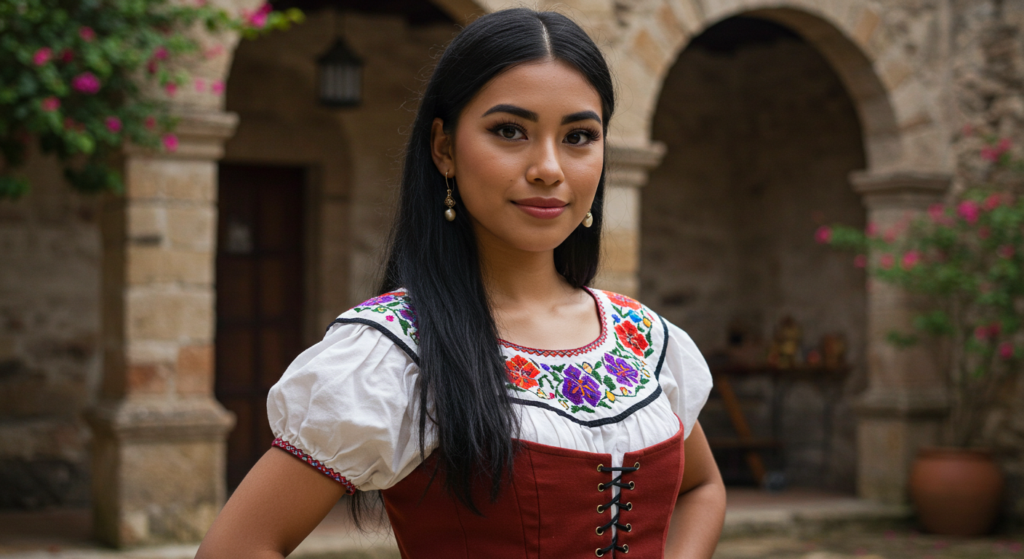
Traditional Huipil Variations
Before Spanish rule, women wore loose tunics called huipiles. They used bright dyes from insects or plants. After conquest, new silhouettes emerged. But some regions preserved the basic tunic shape. They updated it with lace collars or Spanish puffed sleeves. This gave the classic huipil a novel look.
Spanish Bodices and Skirts
Spanish women favored structured bodices that shaped the waist. They also wore wide skirts with pleats or gathers. In Mexico, local seamstresses added colorful embroidery along hemlines. They used motifs from flora and fauna. Women of higher standing might layer petticoats and use fine textiles. This signaled wealth.
Rebozo as Iconic Accessory
The rebozo became a key garment. It blended Spanish shawl elements with Indigenous weaving. Women used it to cover their hair or shoulders. Patterns ranged from simple stripes to complex designs. Over time, the rebozo became a symbol of Mexican identity. Its function spanned social levels.
Men’s Clothing Transformations
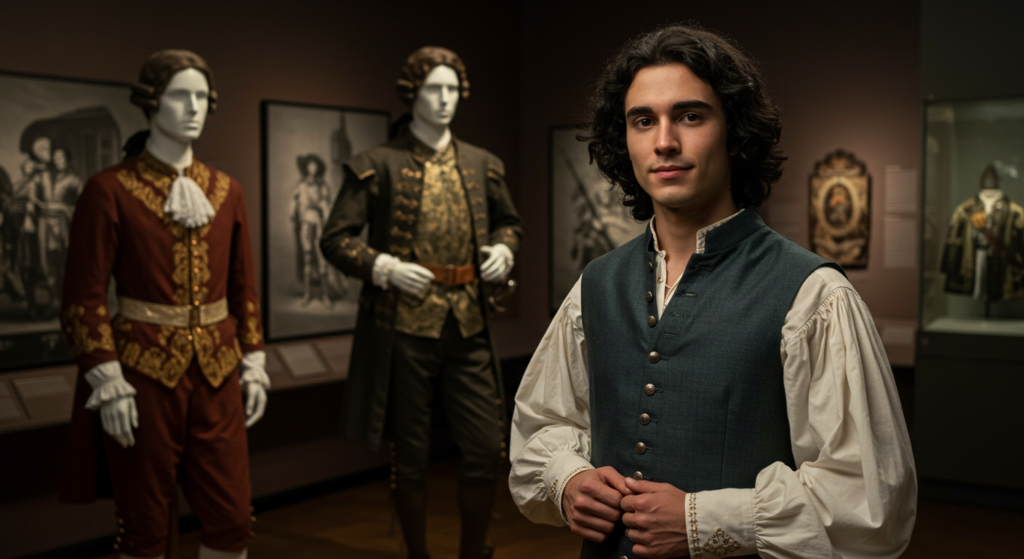
Spanish Jackets and Capes
Spanish men wore short jackets and capes. High-ranking officials donned richly embroidered pieces. Clergy wore long robes and layered garments. Local tailors combined Spanish cuts with local cloth. Wool capes got bright dyes from cochineal or indigo. This gave them an eye-catching look in the streets.
Indigenous Wraps and Sarapes
Men in rural areas stuck to simpler wraps and sarapes. They used thick wool or cotton. They often dyed them in stripes of red or green. Ranchers valued these garments for warmth. Sarapes also served as blankets. Spanish officials tried to ban certain designs. Yet people insisted on wearing them.
Hybrid Breeches and Calzones
Spanish breeches influenced local men’s pants. Some men adopted fitted breeches in fine fabrics. Others wore calzones with a looser fit. They added bright sashes at the waist. These belts might carry knives or coins. Over time, trousers combined Spanish shape with local color preferences.
Children’s Attire and Adornments

Boys and Miniature Suits
Wealthy families dressed boys in suits resembling adult court outfits. Silk or velvet coats, lace collars, and short trousers were common. Craftsmen tailored them to small bodies. Boys of modest means wore simple cotton shirts and pants. They sometimes borrowed older siblings’ garments. Embroidered patches brightened these clothes.
Girls and Flared Skirts
Young girls mirrored adult women’s styles. They wore smaller versions of bodices and skirts. Some had ruffled sleeves or bright belts. Girls from rural areas stuck to huipil-like dresses. Mothers taught them weaving and embroidery early. That passed down local patterns from one generation to the next.
Jewelry and Hair Accessories
Children from affluent homes wore gold earrings and small brooches. They sometimes had silver crosses or bracelets. Girls tied ribbons in their hair. Flowers were also a favorite. Boys wore simpler ornaments, like woven hats. Many families viewed these details as a status symbol.
Religious Influence on Clothing
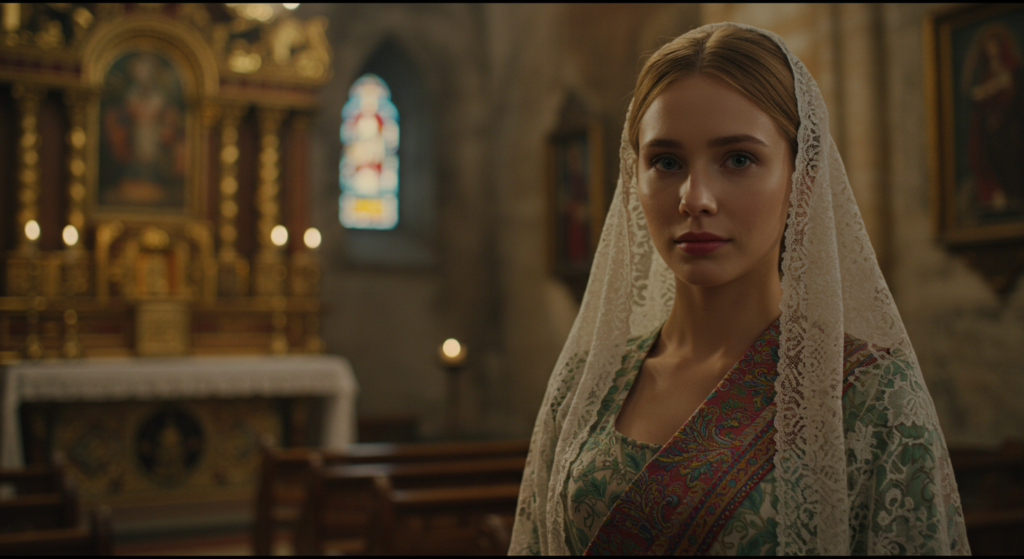
Church Dress Codes
Catholic authorities expected modesty at Mass. Women covered their hair with veils or rebozos. Wealthy ladies wore black lace mantillas. Men removed hats upon entering. During religious feasts, people wore their finest attire. Colorful processions brought out embroidered banners and robes. These events showcased local color mastery.
Clergy Vestments
Priests wore ornate vestments. Silk, brocade, and gilded thread were common. Designers included local motifs, like cactus flowers or stylized eagles. Monks wore simpler habits. But even simple robes could show subtle local dye work. Churches also displayed embroidered altar cloths with Spanish and Indigenous details.
Religious Brotherhoods and Costumes
Lay brotherhoods marched in special robes during processions. They chose distinct colors for each group. Some used red from cochineal. Others used blue from indigo. They included insignias that referenced their patron saints. These outfits revealed how religion influenced color choices in local dress.
Regional Variations Across New Spain
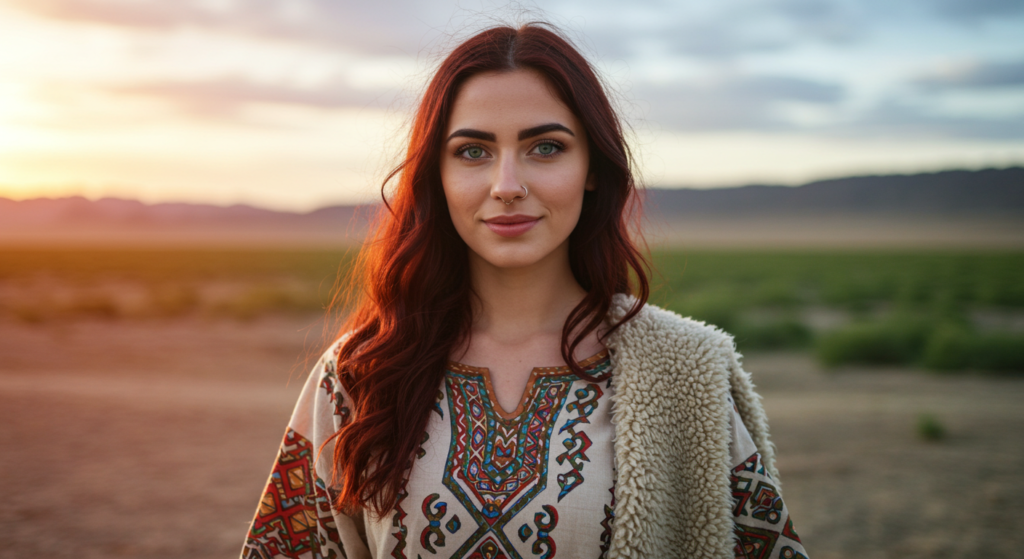
Northern Frontiers
In the north, harsh weather shaped attire. Thick wool and layered garments kept people warm. Fur-lined capes were prized. Spanish ranchers wore wide-brimmed hats and sturdy boots. Local dyes gave earthy reds and browns to daily wear. Geometric patterns from nomadic groups also appeared.
Central Highlands
Mexico City sat at the heart of trade. Elite families had access to silk, lace, and velvet. They donned European-style gowns and suits. Rural people nearby relied on cotton and maguey fibers. Their clothes showed Indigenous weaving. Markets in the capital offered both local and foreign fabrics.
Coastal Influence
Ports along the Gulf and Pacific saw more tropical climates. Light cottons prevailed. Sailors often wore striped shirts and wide trousers. Elegant residents used airy silks or linen. Coastal outfits showed breezier silhouettes. They included bright floral prints, often borrowed from Asian imports.
Colorful Embellishments and Accessories

Embroidered Shoes
Shoemakers created footwear with local flair. They used woven straps or embroidered leather. Ladies’ shoes might have floral motifs on the toe. Elite men wore boots with silver spurs. Those who couldn’t afford imported goods found local craftsmen skilled in design and color application.
Hats and Headpieces
Straw hats were standard in sunny regions. These hats often had ribbons or beaded bands. Spanish gentlemen wore felt hats in cooler climates. Wealthy women wore lace mantillas for social events. Indigenous groups wove palm fronds into headpieces with geometric shapes. This added artistry to daily wear.
Decorative Belts and Sashes
Sashes defined waistlines and carried personal items. They came in many colors and patterns. Artisans often used backstrap looms to create them. Spanish influences appeared in metal buckles or embroidered heraldic symbols. Locals added stylized birds and floral designs. These sashes became prized gifts.
Influence of Guilds and Artisan Workshops
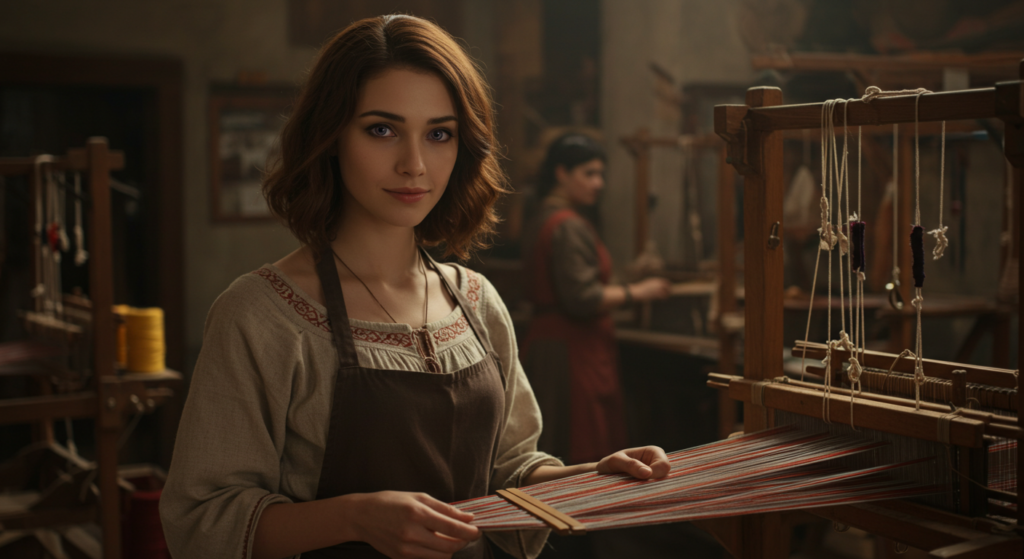
Guild Structures
Spanish authorities set up craft guilds. Members specialized in weaving, tailoring, and embroidery. Guild masters taught apprentices. They controlled product quality and design. This system spread European techniques. Local weavers brought their own methods. That led to unique results in color and pattern.
Tailors and Weaver Collaboration
Tailors cut and shaped garments. Weavers produced the fabric itself. Some tailors created new silhouettes. Then weavers matched colors or patterns to suit them. This interplay fueled innovation. Spanish demands for fancy attire pushed local artisans to experiment with bolder designs.
Competitive Markets
Guilds competed for clients. They boasted about fine dyes and stitching. Some workshops catered to nobles or clergy. Others served everyday folks seeking decent outfits. The guild system helped standardize skills. It also helped preserve traditions. That provided a formal route for local talent to thrive.
Symbolic Motifs in Fabrics

Flora and Fauna
Local weavers loved to depict animals and plants. Agave leaves, birds, and flowers decorated cloth. Spanish motifs also appeared, like lions or castles. Symbols of Catholic saints graced vestments. People blended these images in fresh ways. That produced fascinating designs across the colony.
Heraldic Imagery
Spanish heraldry influenced civic and noble attire. Coats of arms appeared on cloaks and banners. Embroiderers stitched crowns or eagles on official garments. Local families adopted new crests. They merged them with older tribal symbols. This synergy shaped a layered visual vocabulary.
Stylized Geometry
Indigenous crafts used geometric shapes to convey meaning. Triangles, lines, and spirals referenced ancient beliefs. Spanish lace introduced floral or scalloped edges. The two styles combined. That created new patterns with bold angles and soft curves. Artisans adapted them for clothing, blankets, and tablecloths.
The Impact of Climate and Environment

Adapting Fabrics to Heat
Colonial Mexico varied in temperature. Coastal regions demanded airy cloth. Linen and lightweight cotton dominated. Spanish wool was too heavy for humid conditions. Local climate encouraged short sleeves or open necklines. People in these areas wore brighter colors that reflected sunlight.
Wool in Highland Areas
Mountainous regions got cold nights. Sheep herds multiplied, providing wool. Artisans in these highlands spun thick yarn. They crafted ponchos, jackets, and quilts. The Spanish introduced sheep breeding. Locals combined that with their weaving skills. These cozy garments shielded wearers from wind.
Dye Sources in Different Zones
Cochineal thrived in central and southern zones. Indigo grew better in warmer regions. Pomegranate and other plant dyes came from varied environments. Artisans swapped these dye goods across regions. That expanded each area’s color range. Traders moved seeds, insects, and knowledge around.
Celebrations and Festive Attire
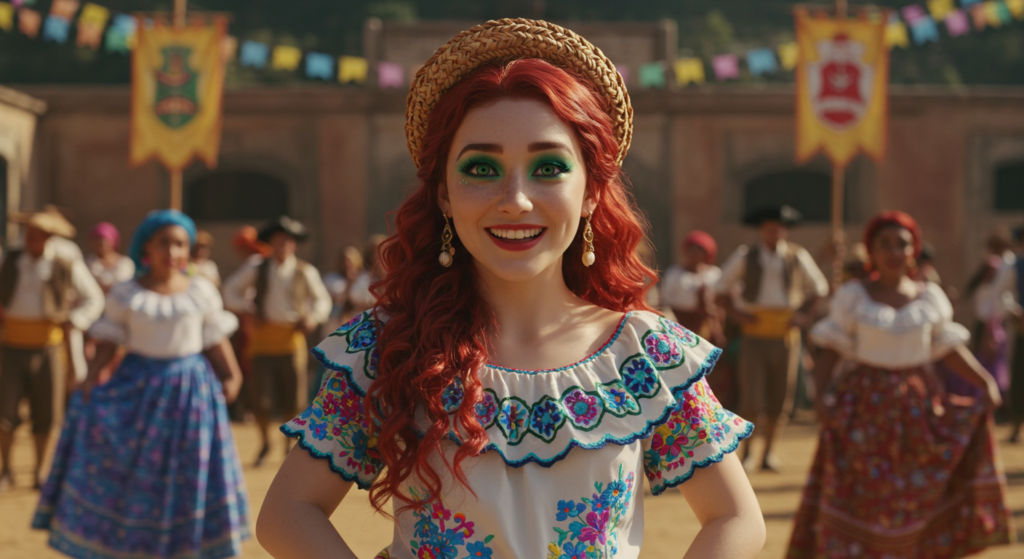
Weddings
Colonial weddings showed off the couple’s status. Brides wore bright red or gold-trimmed dresses if they could afford them. Others opted for white cotton with subtle embroidery. Grooms might don tailored jackets and embroidered cuffs. Weddings gathered families in lavish attire. They honored Catholic tradition fused with local style.
Festivals and Fairs
During local fairs, entire communities dressed up. Dancers wore embroidered outfits that dazzled watchers. Musicians sported decorated hats. Vendors displayed woven shawls and bright wraps. Many used themes drawn from nature or Catholic symbols. Colorful ribbons and sashes flew in lively motion.
National and Religious Holidays
Throughout the year, patrons honored saints. Towns hosted processions full of color. Participants wore their best shawls or tunics. Musicians led parades in matching attire. Priests oversaw mass in grand vestments. These celebrations kept weaving arts in high demand. Everyone craved fresh, eye-catching outfits.
Role of Jewelry and Metallic Accents
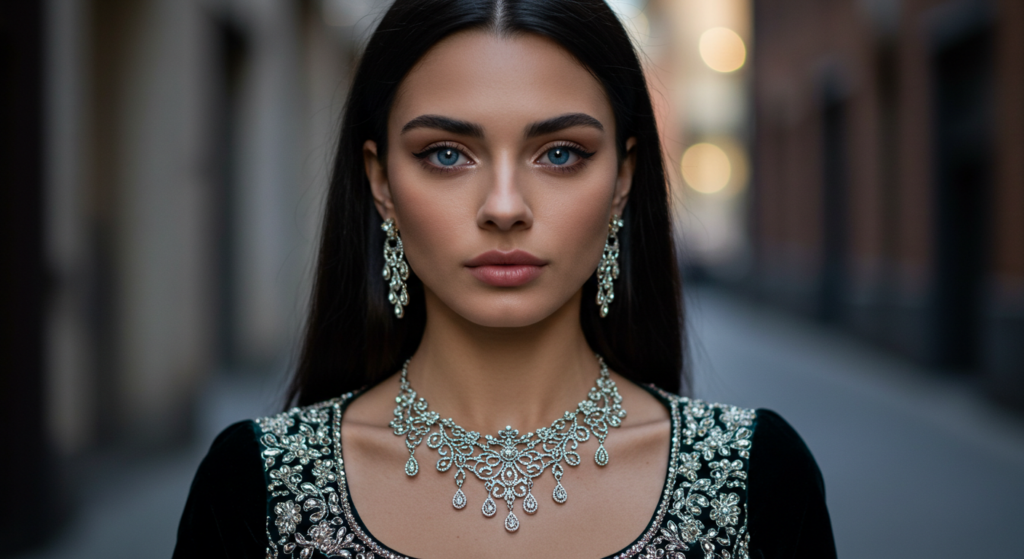
Silver and Gold Elements
Mexico’s mines produced silver in large amounts. Jewelers used silver for brooches, buckles, and religious pendants. Gold remained rarer. Only nobles or clergy flaunted gold belts or necklaces. Many artisans hammered precious metals into filigree shapes. Locals combined them with bold stones like turquoise.
Gemstones and Colored Stones
Emeralds, amethysts, and pearls arrived through trade. Elite families wore these stones in rings or earrings. Craftsmen shaped local jade into pendants. Some items featured carved patterns that hinted at Indigenous motifs. Noble women pinned gemstone-encrusted combs in their hair. Men wore gemstone-studded sword hilts.
Impact on Fashion Identity
Metallic touches signaled wealth and power. A silver buckle or gold trim elevated a garment. The Spanish valued regal splendor. Local artisans found ways to match that taste. They created intricate metal details that didn’t overshadow the colors in the fabric. This delicate balance kept outfits harmonious.
Evolving Tastes Over Time

Borrowing from Indigenous Roots
Spanish colonists once shunned local motifs. Over generations, attitudes shifted. Spanish families embraced the bold local colors. They wanted embroidered details from talented Indigenous artisans. Some even swapped stiff European collars for simpler neckline styles. This acceptance of local flair spurred more creative fusions.
Influence of Creole Identity
People of Spanish descent born in New Spain were called Creoles. They formed a distinct group. Their pride grew in local crafts. Creole families wore outfits that highlighted Indigenous dyes. They recognized the uniqueness of local weaving. This pride formed a new Mexican identity in clothing.
Transition Toward Independence
As social tensions rose, so did pride in local garments. People turned away from strict Spanish codes. They chose more Indigenous patterns and colors. This shift hinted at the desire for cultural self-expression. By the late colonial era, clothing carried messages of unity and local pride.
Changing Fashion in the Late Colonial Era

New Silhouettes
Near the end of the colonial period, European fashion changed. Waistlines rose and sleeves got puffier. This drift spread to Mexico. Local dressmakers adapted these trends. They retained bright dyes and strong embroidery. Women’s gowns merged empire waistlines with native flair.
Tailored Military Uniforms
As militias formed, soldiers wore structured uniforms. They used Spanish patterns but with local modifications. Buttons and badges showed rank. Colors often matched regional resources, like indigo or cochineal. These uniforms represented discipline and unity. They also set a new standard for men’s attire.
Popularity of Lightweight Fabrics
Late colonial life saw more reliance on cotton and linen. Trading routes ensured stable supply. People found these fabrics more practical. They also cost less than silk or velvet. Locals enjoyed painting, dyeing, and embroidering these light materials. That made them both stylish and comfortable.
Conclusion

Fashion in Colonial Mexico reflected a vivid tapestry of Spanish heritage and Indigenous artistry. Authorities sought to control what people wore. Still, local creativity thrived.
New weaving methods and dye sources blossomed. Classes blended influences, forging a distinct identity. Trade brought silks and laces from abroad, while local dyes made them shine.
Clothing showed social rank, but it also became an art form. Over time, proud Creole and Indigenous designers merged shapes, colors, and motifs. That heritage remains visible in modern Mexican textiles.
Summary Table

| Aspect | Spanish Influence | Local Adaptations |
|---|---|---|
| Fabrics | Silk, velvet, lace | Cotton, agave, wool |
| Colors | Deep reds, blues, metallic hues | Earthy browns, cochineal red, indigo blue |
| Silhouettes | Structured bodices, fitted breeches | Loose huipiles, sarapes |
| Embroidery & Motifs | European lace and heraldic crests | Flora, fauna, geometric indigenous patterns |
| Trade Goods | Asian silks, European lace, metalwork | Local dyes, woven stripes, backstrap loom pieces |
| Social Markers | Strict dress codes, sumptuary laws | Creative fusions, subtle subversions |
| Accessories | Mantillas, capes, gilded trimmings | Rebozos, woven belts, straw hats |
| Festive Events | Formal gowns, embroidered church vestments | Bright tunics, rebozos, beaded hats |
FAQ
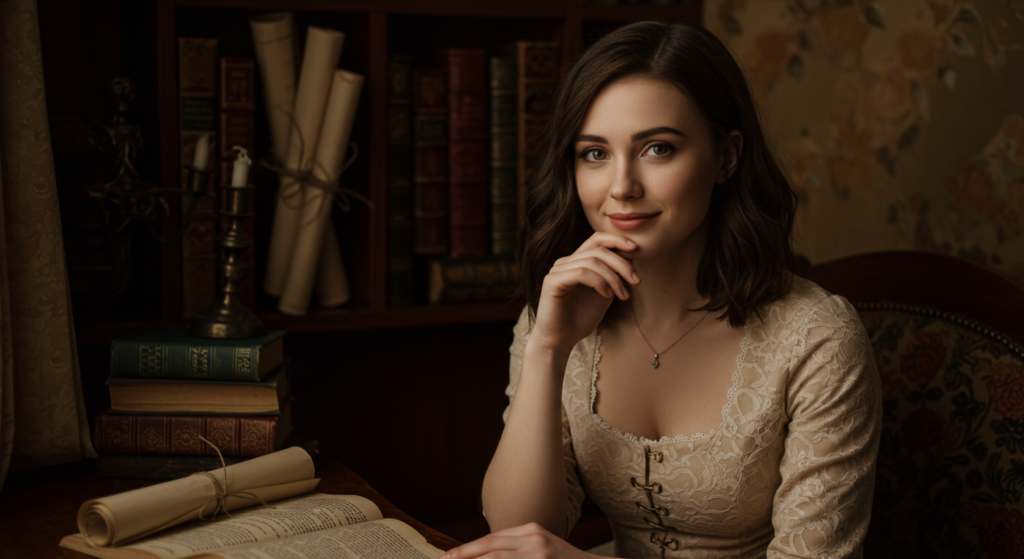
What fabrics were most common during this period?
Silk and velvet thrived among elites. Cotton and wool prevailed for the common folk.
Why was cochineal dye so popular?
It produced a vivid red. This color commanded high value in Europe. Mexico exported it widely.
Did Indigenous styles disappear under Spanish rule?
No. Many endured. They blended with Spanish silhouettes. That led to hybrid fashions.
How did trade routes affect local dress?
Ships from Asia and Europe brought new fabrics. Local artisans adapted them. That enriched overall style.
Which accessories best represent colonial Mexico?
The rebozo, lace mantilla, embroidered belts, and wide-brimmed hats were key icons.
Fashion in Colonial Mexico remains a captivating study in cultural exchange. Spanish influence enriched local tradition. Vibrant hues and diverse materials set this era apart. Modern Mexican style owes much to that creative period.

Brenda Tillman is a color maestro who brings artistic brilliance to every piece she crafts. Passionate about imaginative expressions, she illuminates the world of fashion with her expert guidance on shades and combinations. Beyond her writings, Brenda is a culinary enthusiast and a global traveler, infusing her work with diverse insights. Her unique touch transforms simple color choices into art.
Reviewed By: Joanna Perez and Anna West
Edited By: Lenny Terra
Fact Checked By: Matthew Mansour
Photos Taken or Curated By: Matthew Mansour
